
|
The Chameleons of Madagascar (DVD) by Ardith Abate and Edward Abate (Producers) BeLLA NaTura Productions, San Diego, CA, 2004 An 80 minute documentary that's nearly all footage of wild chameleons in Madagascar. There's also a little material on chameleons from outside of Madagascar, and some material on other Madagascar wildlife and wild lands. The information is richer than you'd find in more general nature documentaries. More than two dozen species are covered, some briefly and others in considerable detail. Includes beautiful footage of some species that at the time this video was made were hard to even find photographs of elsewhere. The DVD itself is now very hard to track down, but its video is (at least as I write this) available on YouTube. |
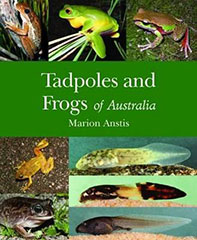
|
Tadpoles and Frogs of Australia by Marion Anstis New Holland, Sydney, Australia, 2013 This massive volume is the culmination of a lifetime of dedication to studying Australia's frogs, including a decade of traveling the country in a laboratory-equipped campervan. The result is an astonishing work of incomparable detail. Each species has several pages devoted to it, with multiple photos of adult frogs and multiple photos of tadpoles at different stages of development, along with a comprehensive text description and precise range map. Most species also include beautiful and precise hand drawn images illustrating the mouth parts or a side view of the tadpoles. Everything you or pretty much anyone else has ever wanted to know about every Australian frog can be found in this book. |

|
Reptiles and Amphibians of Europe by E. Nicholas Arnold and Denys W. Ovenden Princeton University Press, Princeton, NJ, 2002 Solid field guide structured like the old Peterson Field Guides: Illustrations are excellent color paintings grouped together, sometimes with multiple specimens to show variation. Small black-and-white maps are grouped together at the end of the book. Text includes brief, clear species descriptions with an emphasis on identification, along with dichotomous keys and some general information. |

|
Handbook of Reptiles and Amphibians of Florida, Part One: The Snakes, Second Edition by Ray E. Ashton, Jr. and Patricia Sawyer Ashton Windward Publishing Inc, Miami, FL, 1988 This is a useful and well-researched field guide. Each species is illustrated with one or more color photos mixed in with the text, and a range map by Florida county as well as a smaller map showing the entire range in the U.S. The text is informative but a little dry. An uninspired layout makes it a little harder to find what you're looking for than it should be. Overall a good to very good field guide, but Tennant's newer one is even better. |

|
Handbook of Reptiles and Amphibians of Florida, Part Two: Lizards, Turtles, & Crocodilians, Revised Second Edition by Ray E. Ashton, Jr. and Patricia Sawyer Ashton Windward Publishing Inc, Miami, FL, 1991 See Part One for details. Good, but superseded by the newer Bartlett guide. |

|
Handbook of Reptiles and Amphibians of Florida, Part Three: The Amphibians by Ray E. Ashton, Jr. and Patricia Sawyer Ashton Windward Publishing Inc, Miami, FL, 1988 See Part One for details. Good, but superseded by the newer Bartlett guide. |

|
The Herpetofauna of Komodo, with Notes on Adjacent Areas Bulletin of the Florida State Museum Biological Sciences Volume 25 Number 2 by Walter Auffenberg University of Florida, Gainesville, FL, 1980 This 118-page article describes each herp living on Komodo in some detail, including the formal descriptions of several previously unclassified species and subspecies. It includes scientifically detailed pen and ink drawings of some species. It does not include maps, but it does describe habitat and locality for each species. There's no other modern reference for this area, so if you're visiting Komodo and interested in any of the herps other than the dragons, try to track down a copy of this out-of-print journal. Thanks to Peter May for finding me a copy. |

|
The Behavioral Ecology of the Komodo Monitor by Walter Auffenberg University of Florida, Gainesville, FL, 1981 At the time of its publication, this was probably the most comprehensive treatment of a single reptile species ever published. (Since then, Auffenberg has topped it twice with his treatments of Gray's Monitor and the Bengal Monitor.) It's filled with copious text, charts, tables, and graphs chock full o' data about Komodo dragons and their habitat. This is still the authority on matters Komodo-esque. Includes several black and white photographs along with many line drawings. |

|
Mamirauá: A Guide to the Natural History of the Amazon Flooded Forest by Matt Bannerman Instituto de Desenvolvimento Sustentável Mamirauá, Tefé, Brazil, 2001 A good reference for this particular area in Amazonian Brazil, covering the flora, fauna, environment, and history of Mamirauá. The herp information in the main text has some good information and a few nice photos, though it doesn't try to be comprehensive. What sold me were the species lists in the appendices. Those lists aren't complete either (I saw at least one lizard and probably two that aren't listed), but they were still quite useful for me as a herp-interested visitor to this reserve. |
|
|
A Field Guide to Australian Frogs by J. Barker, G. C. Grigg, and M. J. Tyler Surrey Beatty & Sons, Chipping Norton, NSW, Australia, 1995 A solid and comprehensive field guide. Each species account is accompanied by a range map and at least one color photo. Species accounts include detailed descriptions, size and habitat information, a textual description of the call (always amusing with frogs), information about breeding and larval forms, and comparisons to similar species. Within genera, the species are arranged by related groups, which can be helpful or annoying depending on how you're using the book. |

|
Florida's Snakes: A Guide to Their Identification and Habits by R. D. Bartlett and Patricia Bartlett University Press of Florida, Gainesville, FL, 2003 Something funny seems to have gone on with the Bartletts, Alan Tennant, and the snakes of Florida. In 1997 Gulf Press published Tennant's field guide to the snakes of Florida. Two years later the same publisher released the Bartletts' field guide to the herps of Florida other than snakes. Then in 2003 Tennant's book was rereleased by a different publisher, and the Bartletts came out with this field guide to Florida's snakes from yet another publisher. Does the world really need two extremely similar field guides to the snakes of Florida? (Some of the photographs are even the same, or of the same individual snakes, in the two books.) Well, the world might not, but heck, I've got 'em both. This book has the same general layout and style as the books I just mentioned. |

|
A Field Guide to Florida Reptiles and Amphibians by R. D. Bartlett and Patricia P. Bartlett Gulf Publishing Company, Houston, TX, 1999 This field guide is very well designed, making the perfectly fine Ashton books seem like poor cousins. It does not cover snakes; they are left to Tennant's fine guide from the same publisher. Other than that, it covers every species and subspecies of reptile and amphibian known to be established in Florida, including the many introduced species. Each species gets at least one excellent color photo (collected in a central section), a Florida range map, and a page or so of text nicely divided into appropriately labeled sections. You can find what you're looking for quickly, and what you're looking for will be there. This book has been updated, divided into one volume for amphibians and one volume for reptiles-except-snakes. You should get the newer ones instead of this. |
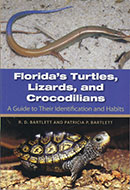
|
Florida's Turtles, Lizards, and Crocodilians by R. D. Bartlett and Patricia P. Bartlett University of Florida Press, Gainesville, FL, 2011 This is an updated version of the reptiles-except-snakes portion of the same authors' 1999 Florida herps-except-snakes guide. The book is a little taller and wider than the old one, and the species photos are larger. The habitat photos have been moved to the introductory "Florida's Habitats" section, which makes sense, but they are now black and white, which is sad. The text has been updated for taxonomic changes and newly established non-native species, and also tweaked throughout. |
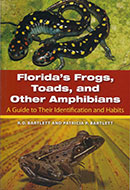
|
Florida's Frogs, Toads, and Other Amphibians by R. D. Bartlett and Patricia P. Bartlett University Press of Florida, Gainesville, FL, 2011 This is an updated version of the amphibians portion of the same authors' 1999 Florida herps-except-snakes guide. The book is a little taller and wider than the old one, and the species photos are larger. The habitat photos have been moved to the introductory "Florida's Habitats" section, which makes sense, but they are now black and white, which is sad. The text has been updated for taxonomic changes and newly established non-native species, and also tweaked throughout. |
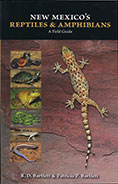
|
New Mexico's Reptiles & Amphibians: A Field Guide by R. D. Bartlett & Patricia P. Bartlett University of New Mexico Press, Albuquerque, NM, 2013 A solid field guide in the style of the authors' (numerous) other field guides. Species accounts are typically a half page to a full page, with a small non-detailed range map. Good color photos are grouped together in the center of the book, labeled with scientific name, common name, and a clue or two to distinguish this from other species. The big Degenhardt, Price, and Painter book has more information about each species, more precise maps, and larger and better-reproduced photos. But that book is too large to transport easily, and some of the taxonomy has changed since it was printed, so this new one is still quite useful. |

|
Snakes of North America, Western Region by R. D. Bartlett and Alan Tennant Gulf Publishing Company, Houston, TX, 2000 Another well-done new field guide, similar in format to the same authors' Florida snakes and other herps guides. One minor complaint about the format is that some subspecies are (arbitrarily?) described in much more detail than others; the distinction between species and subspecies isn't clearly delineated as it is in, for instance, Brown's California snake guide. Also some of the range maps are a little small. But overall, a fine book. |

|
Reptiles and Amphibians of the Amazon: An Ecotourist's Guide by R. D. Bartlett and Patricia Bartlett University Press of Florida, Gainesville, FL, 2003 An attractive field guide similar in size and format to the same authors' other books. Mostly very good photos are grouped together, three to a page. The species accounts are primarily for identification purposes, though a little natural history information is included too. The title is a little misleading, because the book (wisely) makes no attempt to cover the entire herpetofauna of the Amazon basin. Such an undertaking would not fit in any portable book, and would probably never be finished. This book mainly covers the most likely to be seen species from the upper Amazon basin, especially in the vicinity of Iquitos, Peru. If you are traveling to that area it is in invaluable reference. |

|
Discovering Sierra Reptiles and Amphibians by Harold E. Basey Yosemite Association, Yosemite National Park, CA, 1976 Solid little booklet with at least one page and one color photo for each herp species found in the Sierra Nevada. No range maps, but includes textual range information and odd little graphics showing altitude distribution. Good layperson-level identification info (e.g., drawings of belly scales show how to tell a northern from a southern alligator lizard). |

|
Biology of Gila Monsters and Beaded Lizards by Daniel D. Beck University of California Press, Berkeley and Los Angeles, CA, 2005 A roundup of pretty much everything known about Heloderma. Suitable for professional herpetologists but written in an accessible-enough style that it should be enjoyable reading for anyone interested in the lizards formerly considered the only venomous ones in the world. Two sections of color plates include many photos of each subspecies from multiple locales. |
|
|
The Audubon Society Field Guide to North American Reptiles & Amphibians by John L. Behler and F. Wayne King Alfred A. Knopf, New York, 1979 Covers all North American reptiles and amphibians, rather like a combination of Conant and Stebbins. But this is only an advantage if you have very limited shelf space; Conant and Stebbins's books have more and better information per species, and are much more up to date. This book has gotten very stale in the decades since it was last updated. I'm surprised the Audubon Society still publishes it. This book includes color photos arranged by appearance in a central section. Some species with varied appearances occur multiple times on separated pages. Range maps are with species accounts. |

|
Costa Rica: The Ecotraveller's Wildlife Guide by Les Beletsky Academic Press, San Diego, 1998 This is an introductory guide to Costa Rica's vertebrates (not including fish). It is useful and well-written, but makes no attempt to be comprehensive. About 80 herp species are illustrated and discussed, out of the several hundred species present in the country. Illustrations are good quality paintings. Each illustration is accompanied by common name, scientific name, local names, description, habitat types, and a list of protected areas that contain this species. |

|
Madagascar Wildlife: A Visitor's Guide by Hilary Bradt, Derek Schuurman, Nick Garbutt The Globe Pequot Press Inc, Old Saybrook, CT, 1996 This is a thin travel-guide-sized book full of great photos and somewhat skimpy text covering the most common and spectacular animals a visitor to Madagascar might expect or hope to see. Like Preston-Mafham's much larger and richer book, it includes a useful section describing (a subset of the) species occuring on the major nature reserves. |

|
Field Guide to Snakes and Other Reptiles of Southern Africa, third revised edition by Bill Branch Ralph Curtis Books, Sanibel Island, FL, 1998 An excellent book, with clear range maps and a very good collection of photos (together in a section at the back). Species information is digestible to the non-expert but also full of details of interest to the professional herpetologist. I used this book to try to identify the species or at least genus of herps I saw in East Africa, which sadly lacked a herp guide of its own. Fortunately, this situation has since been corrected with the excellent new East Africa reptiles guide. |
|
|
A Field Guide to Amphibians and Reptiles of Maricopa County by Thomas C. Brennan and Andrew T. Holycross Arizona Game and Fish Department, Phoenix, Arizona, 2005 This is a very small book. Measuring 4.5 x 7 inches and 68 pages long, you could almost call it a thick pamphlet. But don't let that put you off -- it's a beautifully crafted field guide for a single county rich in herps. Each species is illustrated with an excellent color photo from which the animal has been extracted and placed on a white background to eliminate distractions. Most photos have callouts to point out significant appearance characteristics. For each species, the page facing the photo of that species has a rich paragraph of information and a county map outline showing the current range, and also the historical range when the two are significantly different. Before the species accounts, a few chapters include well-chosen information about herps in this area, including a detailed map of natural areas in this well-populated county. The next year the same authors and publishers released a similarly excellent statewide guide, but you should still buy this one also, partly for the county-specific information, and partly just to reward the authors and publishers for its existence. Also, it's insanely inexpensive for the quality of the production; I think I paid eight dollars for it. |

|
A Field Guide to Amphibians and Reptiles in Arizona by Thomas C. Brennan and Andrew T. Holycross Arizona Game and Fish Department, Phoenix, Arizona, 2006 This is the big sibling to the same authors' Maricopa County guide from the previous year. It has the same basic layout but in a larger format, and is similarly outstanding. Each species gets at least one photo (larger than in the Maricopa County guide, sometimes the same photo but often different) and a rich paragraph of natural history information (longer than in the Maricopa County guide, and in many cases with even more up-to-the-minute information about size records and such). Many of the photographs are accompanied by drawings showing scalation details. The authors are also behind the excellent Reptiles and Amphibians of Arizona website. Like the Maricopa County book, this book is remarkably inexpensive, something like twelve dollars. Buy two and give one to a friend! |

|
A Field Guide to Snakes of California by Philip R. Brown Gulf Publishing Company, Houston, TX, 1997 California volume of this excellent snake field guide series. (I've got the Florida volume; there's also a Texas volume that I don't have.) Good, detailed species accounts with range maps, excellent color photographs (grouped together), the whole works. |

|
A Guide to the Reptiles and Frogs of the Perth Region by Brian Bush, Brad Maryan, Robert Browne-Cooper, and David Robinson University of Western Australia Press, Nedlands, Western Australia, 1995 This colorful field guide is written by four naturalists who are not professional herpetologists, and more power to 'em. Each of 91 species native to the Perth region of Western Australia is treated to a one or two-page account, including at least one large color photograph. There's also quite a bit of supplementary material about habitats, conservation, snakebite, and other topics. Fine touches abound, from the location name accompanying each photograph to line drawings illustrating fine points of scalation in the dichotomous keys. With the vast quantity of herp species in Australia, smaller regional guides like this one can really help simplify identification, and of course are much easier to carry around than complete country-wide guides like Cogger's massive tome. |

|
Reptiles and Frogs in the Bush: Southwestern Australia by Brian Bush, Brad Maryan, Robert Browne-Cooper, and David Robinson University of Western Australia Press, Crawley, Western Australia, 2007 This greatly expanded version of the same suthors' A Guide to the Reptiles and Frogs of the Perth Region is a real treat. It's a high-quality modern field guide with a unique, chummy feel. Each species account includes at least one high-quality photo, a range map, and very specific locale and habitat info. A sentence describes where and how each photographed individual was discovered, e.g. "Raked from spoil heap in wattle woodland at Ajana." In addition to the standard field guide info are a number of chapters about where and how to find herps, and field-herping stories that illustrate the different major ecosystem types of southwestern Australia. Perhaps the most entertaining field guide I've read. |

|
Amphibians and Reptiles of Northern Guatemala, the Yucatán, and Belize by Jonathan A. Campbell University of Oklahoma Press, Norman, Oklahoma, 1998 This meaty paperback is aimed more at the general public than Julian Lee's more academic volume, but covers similar ground. And it's an awful lot cheaper. Color photos for nearly every species are grouped together in the center. The species accounts are good-sized, though not as comprehensive as Lee's. A few species are described using different scientific names (e.g. Campbell uses Norops where Lee uses Anolis), and many species are given different common names. I've used Lee's book as the authority here; Campbell's alternate common names are listed in my "Other Names" sections. |
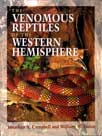
|
The Venomous Reptiles of the Western Hemisphere by Jonathan A. Campbell and William W. Lamar Cornell University Press, Ithaca, NY, 2004 This two-volume behemoth contains virtually all known information about every species of venomous reptile in half of the world. It is aimed at scientists and researchers and includes a wealth of supplemental material in addition to the comprehensive species accounts. Precise range maps including locality dots accompany each species account. The photographs are gathered into sections containing 12 relatively small photos per page; species with interesting variation are represented by multiple photographs. There is also a large section of photos showing the effects of snakebite on people (these photos are not for the faint of heart). |

|
Florida's Fabulous Reptiles & Amphibians by Pete Carmichael and Winston Williams World Publications, Tampa, FL, 1991 This giant volume is first and foremost notable for its top-notch photography. Many species are illustrated with numerous outstanding photos. The text is entertaining and accessible, with a strong conservation message. Species information is good, but nowhere near as comprehensive as the Bartlett field guide. For instance, it only lists 4 of the 10 anole species listed in the Bartlett guide. However, it has 8 great photographs of the brown anole, compared to 1 in Bartlett. |
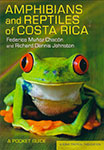
|
Amphibians and Reptiles of Costa Rica: A Pocket Guide by Federico Muñoz Chacón and Richard Dennis Johnston Cornell University Press, Ithaca, New York, 2013 A marvelous little book that's perfectly designed for taking on your next trip to Costa Rica. Each of the 418 currently-described herp species in Costa Rica is listed, with a few carefully worded sentences of identification info, a range map, and one or two excellent color photos (except for a handful of species for which no photo could be obtained). Taxonomy is current as of the publication date. It is subtitled "A Pocket Guide" and indeed it actually fits into my pocket. It is the opposite side of the book info/weight tradeoff as Savage's giant opus. Both are great, but have different purposes; you won't be carrying the Savage book into the field, believe me. |

|
Amphibians of East Africa by Alan Channing and Kim M. Howell Cornell University Press, Ithaca, New York, 2006 An attractive and comprehensive guide. The species accounts include detailed info on identification characteristics, habitat and distribution info, advertisement calls, breeding, and natural history notes. Each species account is accompanied by a dot locality map about two inches square. In addition to the species accounts, there's a hefty quantity of additional information including dichotomous identification keys, a chapter on geography and environment of East Africa, a history of amphibian studies in East Africa, and even a chapter in Swahili. The photos are of good to excellent quality but fairly small, grouped eight to a page in a separate section. |
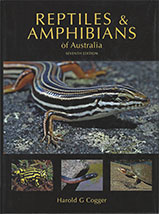
|
Reptiles & Amphibians of Australia, Seventh Edition by Harold G. Cogger CSIRO Publishing, Collingwood, Victoria, Australia, 2014 This whopping 5 pound+ guide is the only book brave enough to cover both all of Australia's reptiles and all of its amphibians. It is an authoritative work, and no one seriously interested in Australia's herps should be without it. This latest edition covers 1218 species. Australian herpetology changes so rapidly that this volume is updated every few years, so even the latest edition is always at least a little out of date. The main text is nicely laid out, with good large color photos for most species, and range maps for all species. The maps and photos accompany the species descriptions. Due to the vast number of species covered, there is space only for a fairly thorough description and a sentence or two on distribution and habitat. Subspecies are also listed, where recognized by the author, but not described. |

|
Watching Wildlife: Australia by Martin Cohen, et al Lonely Planet Publications, Melbourne, Australia, 2000 This book's emphasis is on which Australian wildlife you can see where. Most books of this type don't bother with herps at all. The emphasis of this one is still on birds and mammals, but it also does a good job of highlighting the standout herp species to be found in different areas. It has many authors, but the herp info is by Martin Cohen, so I'll list it under his name here. (Take that, birders!) It was quite useful in planning my 2003 wildlife-watching trip to Australia. Martin and his partner Julia now run Wild About Australia, so others can benefit from their wildlife expertise as I did. |

|
Peterson Field Guide to Reptiles and Amphibians of Eastern and Central North America, Third Edition, expanded by Roger Conant and Joseph T. Collins Houghton Mifflin Company, New York, NY, 1998 The latest edition of this classic. Comprehensively covers the eastern and central United States. Photos of every species (many hand-colored, but you might not notice), accounts, and range maps. In this new edition, the range maps have been mixed in with the accounts, and more drawings and color photos have been scattered throughout. If you're interested in U.S. herps, you need this and its western companion. |

|
Amphibians of Oregon, Washington and British Columbia: A Field Identification Guide by Charlotte C. Corkran and Christina R. Thoms Lone Pine Publishing, Renton, Washington, 1996 As the subtitle suggests, this marvellous little book has one primary aim: to help people in the field answer the question "which amphibian is this?". It succeeds at this goal perhaps better than any other field guide I've ever seen. It includes multiple photographs of each species illustrating all the useful identification features -- even for the egg and larval stages. In addition to these species accounts, it has dichotomous keys for eggs, hatchlings, larva, and adults, illustrated with line drawings. As if that weren't enough, it also has a section with detailed side-by-side comparisons (in text and photos) of easily-confused species. |

|
Desert Snakes by James W. Cornett Nature Trails Press, Palm Springs, CA, 2003 A slim and attractive overview of snakes of the U.S. deserts, similar in scope and approach to 50 Common Reptiles & Amphibians of the Southwest. Each covered snake is represented by a good full-page photograph and a nicely done basic one-page writeup on the facing page. Blindsnakes, Black-headed Snakes, Shovel-nosed Snakes, and Gartersnakes are each written up as a group; the individual species in these groups are mentioned but not described in any detail. Small range maps are included for each covered species or group. |

|
Desert Lizards by James W. Cornett Nature Trails Press, Palm Springs, CA, 2006 Follows the format of the same author's earlier Desert Snakes. An attractive little book, suitable for people with some but not too much interest in the topic. People with too much interest in the topic should head straight for Jones and Lovich's Lizards of the American Southwest: A Photographic Field Guide. Well, I guess people with too much interest in the topic, like me, should get both. |
|
|
A Photographic Guide to Snakes and Other Reptiles of Peninsular Malaysia, Singapore and Thailand by Merel J. Cox, Peter Paul van Dijk, Jarujin Nabhitabhata and Kumthorn Thirakhupt Ralph Curtis Publishing, Inc., Sanibel Island, FL, 1998 This is a beautiful little field guide, with one or more good color photographs of each species in natural or naturalistic surroundings. Each included species gets a paragraph or three about behavior and habitat, and a description of range (no maps). I don't know how far from complete this book is, because I don't have any equivalent book to compare it to (other than the German-language Manthey and Grossman volume). The back cover says "222 species and subspecies selected, representing the full range of reptiles found in Peninsular Malaysia, Singapore and Thailand." I was using it for species whose ranges also included the islands between Bali and Komodo, since I haven't found any reference for that area. It served me moderately well in this capacity. |
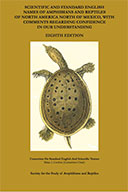
|
Scientific and Standard English Names of Amphibians and Reptiles of North America North of Mexico, with Comments Regarding Confidence in Our Understanding, Eighth Edition by Brian I. Crother, editor Society for the Study of Amphibians and Reptiles, Shoreview, MN, 2017 This thick, inelegantly named, and essential booklet is credited to the SSAR's Committee on Standard English and Scientific Names, chaired by Mr. Crother. Its content isn't surprising given its title, but it's not simply a list of names; my favorite aspect of this book is the considerable space devoted to discussing uncertainties and disagreements among herpetologists. This is the official names list of many (dare I say most?) herpetologists in North America, and is my source for all names of North American species on wildherps.com. This is the eighth edition of this names list. It is available online in PDF form. I don't actually know whether this edition is (yet?) available in printed form. |

|
An Introduction to the Amphibians and Reptiles of Tropical Asia by Indraneil Das Natural History Publications (Borneo), Sabah, Malaysia, 2002 This is mostly a reference for serious herpetologists, focusing on tables and lists rather than details about any species. It includes a table of which species were discovered/described by which expeditions, a table of species with special conservation status, records of export quantities, and more than fifty pages of literature references (out of a 200 page book). For amateur field herpers like me, it has a 67-page color photo section, with a sentence or less describing each displayed species. |

|
Lizards of Borneo by Indraneil Das Natural History Publications (Borneo), Sabah, Malaysia, 2004 This is a very small ("pocket guide") book, but welcome because there is very little in the way of field guides for this part of the world. It starts with a checklist of lizards in Borneo, with the endemic species marked. The rest of the book is a series of species account, each of which has one or two photographs filling most of a page, accompanied by a brief description and notes on distribution. There are 72 species accounts for the 109 listed species, so about a quarter of the species are represented only by their names. The photographs are very good though, and just the idea of seeing the Borneo Earless Monitor (Lanthanotus borneensis) in a field guide is enough to make me want to book a flight now. |

|
A Field Guide to the Reptiles of South-east Asia by Indraneil Das New Holland Publishers (UK) Ltd, London, 2010 A comprehensive guide to the reptiles of this extremely biodiverse region. Approximately half of the book consists of 74 color plates and their facing-page legends, each illustrating five to 15 species with detailed paintings. Most of the remainder is filled with short but detailed species accounts of, according to the cover flap, every recognized species and subspecies in the covered region. Ranges are described in words; there are no range maps. |
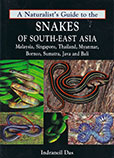
|
A Naturalist's Guide to the Snakes of South-east Asia by Indraneil Das John Beaufoy Publishing, Oxford, England, 2012 A sturdy well-designed little book by one of the world's experts on herps of the covered area. About 250 species are included; each gets about a half-page with one high-quality photo (occasionally two), scientific name, English name, various local names, a few sentences of physical description, a sentence or two about natural history ("habits and habitat"), and distribution info as a list of place names. There are no range maps, but the place names can be compared to color maps on the inside front and back covers. The introduction makes clear that only representative species are included, though there is a complete checklist in the back. |
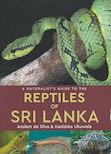
|
A Naturalist's Guide to the Reptiles of Sri Lanka by Anslem de Silva & Kanishka Ukuwela John Beaufoy Publishing, Oxford, England, 2017 A small format, attractive field guide. Species accounts are page long, with one or two very good to excellent photos. A few sentences each for Description, Distribution, Habitat and Habits. No range maps. Grouped by family, with a paragraph or so describing each family. Authoritative but not comprehensive; covers 150 out of more than 200 species known at publication. A complete-for-the-time list of species is included in the back. |
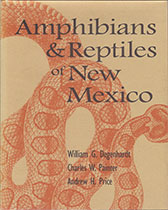
|
Amphibians & Reptiles of New Mexico by William G. Degenhardt, Charles W. Painter, and Andrew H. Price University of New Mexico Press, Albuquerque, NM, 1996 A wonderful big heavy hardbound book with detailed species accounts of all the many herp species found in this state. Excellent large color photos are collected together in the middle. Large and detailed dot-locality range maps are supplied for each species. The species accounts are lengthy, interesting, and informative. Like Petranka's salamander book, its main drawback is that it's so big and heavy that you're not likely to carry it in the field. |
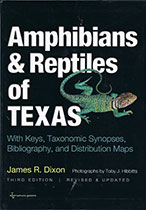
|
Amphibians & Reptiles of Texas, Third Edition by James R. Dixon, with photographs by Toby J. Hibbitts Texas A&M University Press, College Station, TX, 2013 The subtitle of this big heavy book is "With Keys, Taxonomic Synopses, Bibliography, and Distribution Maps", and that's a clear description of what the book does and doesn't contain, except that it also contains large, high-quality color photos on the species account pages. Note that the subtitle does not promise any species descriptions or natural history info, and only a smattering of that kind of info is present. The bibliography is extensive though, and a long list of reference citations accompanies each species account, so the eager reader knows where to look for scientific literature about each species. |

|
The Reptiles of the Upper Amazon Basin, Iquitos Region, Peru by James R. Dixon and Pekka Soini Milwaukee Public Museum, Milwaukee, WI, 1986 This is a combination of two reports published in the mid-1970's, with minor updating. It reads like an academic paper, and illustrates only a few of the species with high-contrast black-and-white photos. So it's quite out of date in content and form, but still contains significant useful information that can help identify and distinguish some of the reptiles found in this area. |

|
Texas Snakes: A Field Guide by James R. Dixon and John E. Werler University of Texas Press, Austin, TX, 2000 This meaty field guide is a condensation of a large hardbound volume (which I don't have, but which looked great when I glanced at in a bookstore). Each taxon account includes a medium-sized photo, a good range map that includes county lines and major waterways (but no dot localities; buy the big book for that), and interesting text divided into Description, Comparable Snakes, Size, and Habitat sections. The accounts are well-written and informative; each is spread across two or four pages. Highly recommended for Texas visitors. |

|
The Amphibians of Great Smoky Mountains National Park by C. Kenneth Dodd Jr. University of Tennessee Press, Knoxville, TN, 2004 An outstanding, comprehensive guide to the identification, natural history, distribution, biogeography, and conservation of the many amphibian species living in this one national park. Full color throughout, with detailed locality maps (within the national park only). Each species has one or more excellent photographs, including many photographs of larval forms that are a great aid to identification. It's a great field guide, and has about 100 pages of material other than the species accounts too. |
|
|
A Checklist of the Herpetofauna and Mammals of Saguaro National Monument by Mary H. Doll, Robert V. Ellis, Richard L. Hayes, Ronnie Sidner, Hugh McCrystal, Dr. Russell Davis, and Dr. Robert L. Hall Southwest Parks and Monuments Association, Tucson, AZ, 1989 A small fold-out pamphlet listing the mammals, amphibians, and reptiles known to inhabit Saguaro National Monument (now National Park) in 1989. Scientific names are listed for subspecies, but the common names are at the species level. Also distinguishes habitat for Desert, Foothills, and Mountains, and provides one-letter Abundancy code. Such a deal at 50¢. |

|
Hylid Frogs of Middle America by William E. Duellman Society for the Study of Amphibians and Reptiles, St. Louis, MO, 2001 A massive two-volume work on this group of frogs. Originally published in 1970 by the University of Kansas, this new edition includes more recent findings and more illustrations. The new material is not well integrated with the original, however; instead it is included as a huge supplement. The illustrations, grouped together at the back of volume 2, are beautifully reproduced paintings by David M. Dennis. Most are color, but some are black and white. This book is exhaustive; you are unlikely to find any information elsewhere on this group of frogs that isn't in this book. Includes range maps with precise record locations for each species. This is a book to leave behind in the library and consult later. |

|
Cusco Amazónico: The Lives of Amphibians and Reptiles in an Amazonian Rainforest by William E. Duellman Cornell University Press, Ithaca, New York, 2005 Comprehensive account of the herpetofauna of one particular reserve in Amazonian Peru. In addition to rich, detailed species accounts, with information very specific to this particular reserve, there are over 100 pages of chapters on such broader topics as the reserve's environment, seasonal patterns, spatial distribution, biogeography, human impact, and more. The photographs are grouped together eight to a page; the photo quality is generally good to very good, but not great. This book was very helpful when I was trying to identify species seen in Amazonian Brazil, but for that purpose I wished for species range maps, alas. |
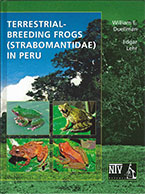
|
Terrestrial-breeding Frogs (Strabomantidae) in Peru by William E. Duellman and Edgar Lehr Natur und Tier - Verlag, Munich, Germany, 2009 A comprehensive overview of a diverse and difficult group of frogs in Peru. Quite a specialized title, but very helpful when trying to identify the little Pristimantis frogs that one invariably sees in Peruvian Amazonia. Amphibian research is a busy field in Amazonia, and some aspects of this book are already out of date, but it's full of information that is hard to find anywhere else. The account of each species contains an inline color photo, a detailed description, and extensive comparisons with similar species. Dot-locality maps are grouped together in the back of the book. |

|
The Frogs and Toads of North America by Lang Elliott, Carl Gerhardt, and Carlos Davidson Houghton Mifflin Harcourt, New York, 2009 A big, colorful, beautifully illustrated and comprehensive guide. Each species has a page or so of text, written for the layperson. Each species account includes at least one full-page photo (and often two or three) along with one or more smaller photos. Together the photos do a great job at illustrating the variation within a species. Subspecies are mentioned briefly, but not shown in the range maps. The book also includes a CD of the calls of all 101 species covered in the book, excepting the two tailed frogs that are not known to vocalize. |

|
The Land of the Komodo Dragon by Claire Ellis Times Editions, Singapore, 1998 This slim hardback provides solid information about Komodo dragons and the greater ecosystem in which they live in an attractive format. It's well illustrated with color photos throughout. It doesn't have enough information to be definitive on any given topic, but the information it does include is sound. It's probably best for people who have visited, plan to visit, or dream about visiting the Komodo National Park themselves. For far more detailed information about the big lizards themselves, read Auffenberg's book. |

|
Turtles of the United States and Canada, Second Edition by Carl H. Ernst and Jeffrey E. Lovich The Johns Hopkins University Press, Baltimore, MD, 2009 Gargantuan compendium of turtle information suitable for professional herpetologists or for anchoring small boats. Contains more than 200 color photographs but seems a little skimpy on the photos given the vast quantity of text. You might think that all known information about every U.S. and Canada turtle species was contained within, but the 170 page ("selective") bibliography suggests otherwise. Still, unless you are a turtle researcher you will probably find everything you have ever wanted to know between these covers. |

|
Turtles of the World by Carl H. Ernst and Roger W. Barbour Smithsonian Institution Press, Washington, D.C., 1989 Solid, authoritative review. There are few enough turtle species that each one can be covered with some depth in a reasonable-sized book such as this. Very good information on the appearance, distribution, habitat, and natural history of each species. Black and white photographs accompany each species account, and color photographs for some but not all species are grouped in the center. Range maps are included only for the family level. |

|
Snakes of the United States and Canada by Carl H. Ernst and Evelyn M. Ernst Smithsonian Books, Washington, D.C., 2003 This is an attractively presented scientific work, the closest serpent analogy to Petranka's great book on salamaders in this same part of the world. The species accounts are detailed and interesting. The color photographs accompanying each species account range from excellent to only average; too many of them are in obviously unnatural poses for my tastes. The range maps do not distinguish subspecies and do not include locality dots, both surprising omissions for a comprehensive work of this nature. Perhaps the book was rushed into publication for some reason, because I noticed some mistakes in the text, and at least one of the photos was printed upside down. It's nice to have a modern work that covers the entire snake fauna of the U.S., but it could have been better. |
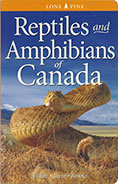
|
Reptiles and Amphibians of Canada by Chris Fisher, Amanda Joynt, and Ronald J. Brooks Lone Pine Publishing, Edmonton, Alberta, 2007 Poor Canada does not have many herps, but this charming book serves them well. The species accounts are illustrated with largish paintings and an occasional additional photograph. Accounts also include some lively natural history info, a French common name, a range map, and thumbnail paintings of similar species. |
|
|
The Reptiles and Amphibians of Anza-Borrego Desert State Park by Nancy Foley, Lee Grismer, and Mark Jorgensen Anza-Borrego Desert Natural History Association, Borrego Springs, CA, 1994 This is a simple, well-done checklist of herps in this large and diverse state park. Includes subspecies names, habitats, and for some species a paragraph of text. |

|
A Complete Guide to Scientific and Common Names of Reptiles and Amphibians of the World by Norman Frank and Erica Ramus N G Publishing Inc, Pottsville, PA, 1996 Matches scientific with common English names for worldwide reptile and amphibian orders, families, genera, and species. Also includes subspecies for groups found in the United States. It's not perfect, and it couldn't possibly satisfy everyone, since authorities disagree and taxonomies are revised. The authors are not herpetologists, and seem to have quickly invented names for many taxa that had no well-established common English names. Some herpetologists feel that this book does a disservice by promoting such names, and would prefer using no common name at all over an invented one by a non-herpetologist. That said, this is the only worldwide guide of its kind, and many (most?) of the names were taken from existing usage (unfortunately, you can't tell by reading which ones are invented and which ones were already established). It's nicely organized such that you can easily look up an entry even if you know only its genus or common name. For North American herps, you should use the notes on scientific and common names. |

|
A Phylogenetic Analysis and Taxonomy of Iguanian Lizards by Darrel R. Frost and Richard Etheridge The University of Kansas Museum of Natural History, Lawrence, KS, 1989 This is the landmark paper that broke up the huge lizard family Iguanaidae (or Iguanidae, depending upon whom you ask) into seven smaller families. Most scientific herpetological literature has adopted this new organization, and so have I. Unfortunately this paper offers no common names for the new families, and Frank and Ramus still use the monolithic Iguanaidae, so I've had to scrounge the web for common names. |

|
A Field Guide to the Snakes of Belize by Tony Garel and Sharon Matola The Belize Zoo and Tropical Education Center, Belize, 1995 Decent species-by-species account of most of the 59 snake species known to be found in Belize when the book was written. No range maps, but includes a table specifying which species have been sighted in which political districts. Each listed species gets a color photo or occasionally two, a description aimed at identification without the need for handling, a sentence or two on habitat, and a short paragraph or two on natural history. A sensible emphasis has been placed on distinguishing the venomous species from the harmless ones. |

|
North American Watersnakes: A Natural History by J. Whitfield Gibbons and Michael E. Dorcas University of Oklahoma Press, Norman, OK, 2004 This is something of a companion volume to Rossman et al's Garter Snakes book, covering the genera Nerodia, Regina, and Seminatrix in place of the older book's Thamnophis. The format is similar, though the range maps here are much improved, using color to clearly distinguish museum records, literature records, and personal observations on a county-by-county basis. The similarly grouped-together color photographs are similarly smallish, but do a good job of covering variations in appearance of each taxa. The content is similarly academic, though I'd say considerably more readable. If you're looking for detailed information about watersnakes in North America, this is the place to start, and often end. |
|
|
Collins Handguide to the Frogs and Reptiles of New Zealand by Brian Gill William Collins Publishers Ltd, Auckland, NZ, 1986 Decent little field guide to the merely 43 species of herps recognized in New Zealand back in 1986. Each species has a page of minimal text and a facing page typically with two good color photographs. There's really not much point to this book nowadays except historical interest, as it was replaced ten years later by Gill and Whitaker. However, it does have different photographs of many (all?) species than the newer version. |
|
|
New Zealand Frogs & Reptiles by Brian Gill and Tony Whitaker David Bateman Limited, Auckland, NZ, 1996 In the ten years since the time Gill wrote the earlier version of this guide, the number of recognized herp species in New Zealand crept up from 43 to a non-whopping 59. These still fit easily into a small, thin field guide, though the thinness is partly due to extremely sparse text. The text here is in many cases exactly the same as in the earlier book, which seems a little unambitious. Big print. Lots of white space. Still, New Zealand does have the amazing tuatara and some beautiful geckos. |

|
A Fieldguide to the Amphibians and Reptiles of Madagascar, Second Edition by Frank Glaw and Miguel Vences Moos Druck, Leverkusen and FARBO, Köln, Germany, 1994 Dense, detailed, complete guide to the many herps on this unique island. Includes hundreds of small color photos in one section, with black and white photos scattered throughout. Also throws in sections on mammals and freshwater fish, oddly enough. Translated effectively but not particularly elegantly from the original German. Not as accessible as a non-expert might prefer, but still invaluable. Henkel and Schmidt's more recent book on Malagasy herps has information more suited to the non-expert on average, but is far less complete. A third edition is now available, which is better in most ways, but this edition still contains quite a bit of detailed information that's not in the newer edition. |

|
A Field Guide to the Amphibians and Reptiles of Madagascar, Third Edition by Frank Glaw and Miguel Vences Vences & Glaw Verlag, Köln, Germany, 2007 This new third edition is a huge improvement over the second edition in many ways. It is larger in every dimension. It has all the new species and taxonomic changes from the thirteen years since the 2nd edition was published. It is much more expensively and beautifully printed; where the 2nd edition has small color photos grouped together in one section, the 3rd edition has medium-to-large color photos throughout, on the pages facing the species descriptions. Species that vary significantly in appearance usually have multiple photos to illustrate that variance. The range maps are now also on the facing pages from the species descriptions, so less thumbing around is required. However, while mostly being an improvement over the 2nd edition, it has also taken a couple of steps backwards. For one thing, it has significantly less detailed text about many species. The authors explain that this was done to accommodate the desire for more and larger photos and the need to cover more species, without growing the book to a vastly larger size that would be prohibitively expensive to produce. In addition, the range maps inexplicably no longer distinguish subspecies, though the text still does. If you can only afford one expensive book about Madagascar herps, this is certainly the one to get. But if you're as interested in the subject as I am, you'd be even happier if you can also dig up a copy of the 2nd edition. |

|
Amphibians and Reptiles of Baja California Including its Pacific Islands and the Islands in the Sea of Cortés by L. Lee Grismer University of California Press, Berkeley, CA, 2002 This large volume will no doubt be the major general reference for herps in Baja California for many years, probably decades. It's comprehensive and well-written, full of scientific information while remaining very interesting to the curious layperson. The layout and graphic design are exceptional, with particularly attractive and clear multi-color range maps. It's a little skimpy on the photographs; detailed multi-page textual accounts are usually accompanied by only one or two small photographs. This photo paucity is partially offset by gorgeous large photographs preceding each chapter that show herps in beautiful wide-angle natural settings. |
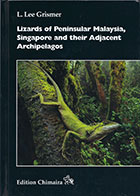
|
Lizards of Peninsular Malaysia, Singapore and their Adjacent Archipelagos by L. Lee Grismer Edition Chimaira, Frankfurt, Germany, 2011 A comprehensive and absolutely gorgeous reference. Over 700 pages printed in full color on heavy, durable, glossy paper. Includes lengthy discussion of the geography, vegetation, and biogeography of the region. The species account are detailed and rigorous, and include large dot-locality distribution maps that show topography of the area. Grismer is well known for his stunning herp photos, and does not disappoint here. Each species is illustrated with at least one photo, but often more; some species accounts include five or six. They range from excellent field-guide-type shots to jaw-dropping wide angle shots that show the lizard in its habitat. I don't know if I'll ever get a chance to go lizard-hunting in this part of the world, but at least I'll be able to stare at this book and dream. |

|
Amphibians and Reptiles of La Selva, Costa Rica, and the Caribbean Slope by Craig Guyer and Maureen A. Donnelly University of California Press, Berkeley, CA, 2005 A fine and detailed paperback field guide to the herps of a particularly well-studied area in Costa Rica, covering 138 species. Range maps are included with the text; color photos (at least one per species) are grouped together. Many of the photographs include human hands holding the animal in some constrained way in order to illustrate a distinguishing feature. One oddity for a book that's aimed at researchers and serious enthusiasts is that the photographs are labeled only with the common English names of each species, ignoring the scientific names. |

|
Amphibians and Reptiles in Colorado, Second Edition by Geoffrey A. Hammerson University Press of Colorado, Niwot, Colorado, 1999 High-quality, detailed field guide. Color photographs and maps throughout. The maps use locality dots and show the major rivers and streams, and thus are very precise. Each species gets a long write-up with lots of natural history information and often multiple excellent color photograph illustrating different behaviors or life stages or appearance variations. |

|
50 Common Reptiles & Amphibians of the Southwest by Jonathon Hanson and Roseann Beggy Hanson Southwest Parks and Monuments Association, Tucson, AZ, 1997 This attractive booklet is part of a series of "50 common this" and "100 common that" of the U.S. Southwest, so the included species list was somewhat arbitrarily chosen to cut off at a nice round number. But don't let that put you off; it's a well-done little guide. There are just a few pages of general information surrounding the species accounts. Each of the 50 chosen species gets exactly one page of information and one high-quality photograph. The text is well-written and sprinkled with interesting facts. |

|
An Annotated List and Guide to the Amphibians and Reptiles of Monteverde, Costa Rica by Marc P. Hayes, J. Alan Pounds, and Walter W. Timmerman Society for the Study of Amphibians and Reptiles, Oxford, OH, 1989 A fine regional booklet, including brief descriptions of each species, common and scientific names, area and microhabitat codes, and dichotomous keys for the difficult groups. I wish it had photos and maps, but other than that it's an excellent little guide. |
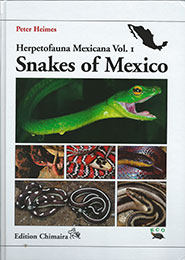
|
Snakes of Mexico by Peter Heimes Edition Chimaira, Frankfurt, Germany, 2016 A massive, detailed, photo-rich, but not uncontroversial book. Species accounts include common names, systematic history, diagnostic details, descriptions, distribution info, and natural history info, with many references and a photo or three. Includes dichotomous keys to each genus with more than two species in Mexico. |

|
A Guide to the Identification of the Amphibians and Reptiles of Hispaniola by Robert W. Henderson and Albert Schwartz Milwaukee Public Museum, Milwaukee, WI, 1984 This is a technical dichotomous key to the large number of reptiles and frog species on Hispaniola (the island containing Haiti and the Dominican Republic). It's also got a few black and white photographs and an authoritative bibliography. A map of the island is partitioned into 20 or so numbered areas; the distribution for each species refers to these numbers. This is clearly aimed at professionals, but a determined amateur can make good use of it also. |

|
Amphibians and Reptiles of Madagascar and the Mascarene, Seychelles, and Comoro Islands by Friedrich-Wilhelm Henkel and Wolfgang Schmidt Krieger Publishing Company, Malabar, FL, 2000 A beauteous hardbound guide, aimed at a less technical audience than Glaw and Vence's Madagascar book. Each species described gets at least a page, sometimes a page per subspecies, and at least one very good color photo. Good descriptions of appearance and behavior, with a little captive care information too. However, note that this book is nowhere near as complete as Glaw and Vence's book; for example, this book lists 14 skink species where Glaw and Vence's book lists 52 (and no doubt more have been identified since Glaw and Vence's book was published). My only other regret is the lack of range maps per species. Some groups have maps with species localities marked, others do not; all species have distributions described in text. |

|
The Natural History of Big Sur by Paul Henson and Donald J. Usner University of California Press, Berkeley, CA, 1993 A thick and juicy overview of the Big Sur area in central California. A few color photos illustrating different habitat types and plant communities; pointilist drawings scattered throughout. The last section talks you through specific trails, pointing out the geology, flora, and fauna you're likely to see. |

|
The Reptiles and Amphibians of Anguilla, British West Indies by Karim V. D. Hodge, Ellen J. Censky, and Robert Powell Reptile Education and Research Publishing, Kansas City, MO, 2003 This is a small narrowly-targeted volume; Anguilla is a nation comprising one small island and a few tiny ones. It is a handy identification guide with a strong conservation message. Each species has a page or two of information, and from one to five decent photographs, most or all taken locally. Along with standard scientific and English names, it includes the charming local names for many groups and species, for example "woodslaves" for geckos, "slipperybacks" for skinks, and "mariners" for sea turtles. For a broader-based but less detailed guide to herps in this area, try Reptiles & Amphibians of the Eastern Caribbean. |
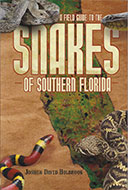
|
A Field Guide to the Snakes of Southern Florida by Joshua David Holbrook ECO Herpetological Publishing and Distribution, Rodeo, NM, 2012 It seems safe to say that the ophidian fauna of Florida is already well-represented on your local bookshelf (or at least on mine, and amazon.com's), with the Bartletts' book, and Tennant's book. But new herp books are always welcome, if they have something to offer. This one has a friendly, casual style and entertaining personal anecdotes that will be appreciated by field herpers in particular. The photos vary in quality, but many of them appear to be of unposed wild animals, which is a style I happen to like. Introductory material discusses Florida's habitats, specific natural areas that harbor a lot of snakes, taxonomy and terminology, and more. |
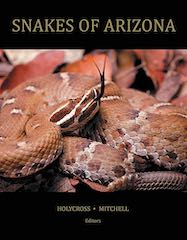
|
Snakes of Arizona by Andrew T. Holycross and Joseph C. Mitchell (eds) ECO Publishing, Rodeo, New Mexico, 2020 A beautiful, comprehensive, and gigantic summary of everything known about snakes in Arizona up to the publication date. Excellent photos, thorough and comprehensible accounts, and full-page dot-locality maps. A new standard in herpetological reference book excellence. |

|
Systematics of the snake-eyed skink genus Cryptoblepharus by Paul Horner Records of the Museums and Art Galleries of the Northern Territory, Darwin, NT, Australia, 2007 This is a journal article in which Paul Horner massively revised the genus Cryptoblepharus. Formerly about a half-dozen species of this genus were recognized in Australia. Afterwards twenty-three were recognized. This will presumably be the definitive work on this genus for some time to come, so I'm going to use it as my basis for identifying these skinks. |

|
Australian Reptiles & Frogs by Raymond T. Hoser Pierson & Co., Sydney, Australia, 1989 Despite the author's claims on his website and elsewhere that this book includes all the species a visitor is likely see in the wild in Australia, I found it disappointingly selective. Many of the species I ran across on a three-week trip in 2003 are not mentioned here. The species that are listed are presented attractively, with large range maps and color photos alongside the text, much in the fashion of Cogger (but far less completely). The information with each species is an odd but interesting collection of natural history tidbits. In addition to species accounts, the book also includes chapters on various aspects of conservation and captive care. |

|
Mountain Kings: A Collective Natural History of California, Sonoran, Durango and Queretaro Mountain Kingsnakes by Brian Hubbs Tricolor Books, Tempe, AZ, 2004 Big book with a long title and lots of text; there's no skimping here. Hubbs is not a professional herpetologist, but he has vast field experience and knows his mountain kingsnakes. This is a treasure trove of details about the four species it covers, and anyone with a particular interest in these beautiful snakes would be foolish not to buy a copy pronto. Large and extremely detailed range maps are included as fold-outs. Black and white photographs are generously scattered throughout; color photographs are also included in a 16-page section. I mostly really enjoy the copious personal anecdotes, but I was occasionally turned off by apparent condescension towards the professional herpetological community. |

|
Common Kingsnakes: A Natural History of Lampropeltis getula by Brian Hubbs Tricolor Books, Tempe, AZ, 2009 If you want to know every detail of everything Mr. Hubbs has ever learned about this species — and he has learned a vast amount — then this is the book for you. With the same height and width as his earlier Mountain Kings book, but with an even larger page count, you would be hard-pressed to find another book with this much data about any reptile species. Black-and-white and color photographs of every morph and pattern class and subspecies are packed into photo sections and also distributed throughout, along with habitat photographs and detailed locality maps. You might be overwhelmed, but you will not be bored. |
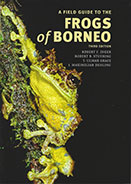
|
A Field Guide to the Frogs of Borneo, Third Edition by Robert F. Inger, Robert B. Stuebing, T. Ulmar Grafe, and J. Maximilian Dehling Natural History Publications (Borneo), Kota Kinabalu, Malaysia, 2017 The third edition brings this book back into authoritative competition with the excellent Frogs of Borneo website. The species lists are nearly identical now, and the two references complement each other well. Nearly all species include at least one excellent color photo, sometimes multiple photos. Each species includes a short-ish description, a sentence or two about habits and habitats, a phrase about the call, a sentence about the distribution, and sometimes a sentence or two about the tadpoles. The website (by a different set of frogologists) has generally more photos, and overlapping information. Neither has any sort of maps, unfortunately; all distribution info is described only in text. |

|
Anoles: Those Florida Yard Lizards by Steven B. Isham Commahawk Publishing LLC, Orlando, Florida, 2006 This is a charming introduction to the behavior, biology, and history (both natural and otherwise) of anole lizards in Florida. Steven Isham has done a remarkable job of learning from the experts and boiling this knowledge down into an entertaining and educational book, suitable for people of all ages. The illustrations by Henry Flores vary in quality, but the best of them are both beautiful and scientifically precise. With a strong but not overbearing pro-environment message, this would make a great gift for anyone with the slightest interest in Florida wildlife. |

|
The Amphibians of Java and Bali by Djoko T. Iskandar Research and Development Centre for Biology—LIPI, Indonesia, 1998 A solid, authoritative summary of the frogs and caecilians of these two islands, appropriate for both researchers and enthusiasts. About a page of info on each species, and one good photo of most species in a separate section. |

|
Galápagos: A Natural History by Michael H. Jackson University of Calgary Press, Calgary, Alberta, Canada, 1993 Probably the best naturalist's overview of the Galápagos islands. Black and white photos throughout the text complement the twenty-page color photo section. The reptile chapter includes a table mapping all present species to the islands on which they occur. |

|
Amphibians and Reptiles of Georgia by John B. Jensen, Carlos D. Camp, Whit Gibbons, and Matt J. Elliott The University of Georgia Press, Athens and London, 2008 This is a marvelous doorstop of a book, filled with the latest information about the natural history, conservation status, and range of the herps in Georgia. The species accounts are works of art, with large, highest-quality photographs mixed with detailed information in a very attractive graphic design. The range maps are among the finest I've seen in any herp books, using dots to mark the counties with documented records, open circles to mark the counties with other records, and a colored wash to show the predicted range. Next to the large detailed Georgia map is a small map showing the species range throughout the USA. Amphibian accounts include clear photos of larval forms. Supplementary material includes a detailed per-species references section, a chapter on conservation, and a listing of Walter Knapp's Georgia frog vocalization mp3 files available for downloading. Every aspect of this book seems complete and carefully chosen. This sets the new standard for U.S. state herp references. |

|
Lizards of the American Southwest: A Photographic Field Guide by Lawrence L. C. Jones and Robert E. Lovich, editors Rio Nuevo Publishers, Tucson, Arizona, 2009 This wonderful book is the intellectual heir to Hobart Smith's landmark Handbook of Lizards, though it covers a smaller geographical area. It has far more information per species than standard field guides, a whopping four pages with a large range map that includes subspecies, and multiple excellent photos of animals in their natural habitats. Each species account is written by one or more experts on that species; there are dozens of individual authors. The copious text even includes viewing tips for each species. It's all very well-written and well-edited. It includes a variety of articles pertaining to various aspects of lizardalia before and after the species accounts. I have one fairly major gripe that I hope gets addressed in some future edition — the maps include subspecies ranges, but figuring out which subspecies goes with which color on the map is a puzzle that involves looking at the map, looking at the alphabetical listing of subspecies (usually a page turn away), and looking at page 559, which shows the order of map colors that matches the alphabetical order of subspecies. But don't let that complaint keep you from obtaining this very high-quality book. |
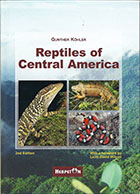
|
Reptiles of Central America, 2nd Edition by Gunther Köhler Herpeton Verlag, Offenbach, Germany, 2008 This is the 2nd edition of an English-language combination and translation of two earlier German-language books. The introduction says that it is intended for both herpetologists and travelers, but it's much more of an academic reference than a field guide for the layperson. However, everyone with an interest in herps will be attracted by its comprehensive nature and the generous quantity of good color photographs. For each genus inhabiting the area it provides some citation-rich habitat and behavioral information and a dichotomous key for identifying the species; for each species it provides the original reference and type locality, and a good range map. Many but not all species are illustrated with color photos. There are a number of good references out there for Costa Rican reptiles, but as far as I know this is the only general reference for all Central American reptiles. |
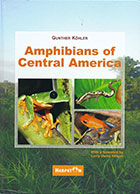
|
Amphibians of Central America by Gunther Köhler Herpeton Verlag, Offenbach, Germany, 2011 This is the more recent companion volume to the same author's Reptiles of Central America. Like that book, it fills an important role in providing a general reference for the animals across all of Central America, since the countries in that region other than Costa Rica are not well represented by herp guidebooks. It has the same format as the Reptiles book. |

|
Amphibians & Reptiles of Yellowstone and Grand Teton National Parks by Edward D. Koch and Charles R. Peterson University of Utah Press, Salt Lake City, UT, 1995 This is an unusal regional herp guide because there are very few different amphibians and reptiles in the area covered -- 12, plus 4 "possibles". You wouldn't think that would be enough to make a decent-sized book from, but this is a decent-sized book (188 pages). The happy key to this puzzle is that there is much more information about each species than you find in most such books, including very precise maps and descriptions of where each species has been recorded in the area. If you are a herper, and you are visiting one or both of these parks, you would be silly not to have a look at this book (available in park bookstores at least when I was there in the summer of 2001). |

|
Ranas de hoja de Costa Rica (Leaf-frogs of Costa Rica) by Brian Kubicki Instituto Nacional de Biodiversidad, Costa Rica, 2004 This book comes out of Kubicki's seven years of studying amphibians in Costa Rica, where he founded the Costa Rican Amphibian Research Center. The book covers six related species of frogs in the genera Phyllomedusa and Agalychnis, including the famous Red-eyed Leaf Frog (Agalychnis callidryas) pictured on the cover. After some background material, each species is covered in considerable detail, and the book is illustrated throughout with many beautiful and artistic photographs. The text is in English (left-facing pages) and Spanish (right-facing pages) throughout. |

|
The Amphibians and Reptiles of the Yucatán Peninsula by Julian C. Lee Cornell University Press, Ithaca, NY, 1996 This is a gigantic, very expensive, and comprehensive work. It's laid out like the biggest field guide you've ever seen, organized around species accounts. The accounts are detailed and scientific, though not inaccessible. Each account is illustrated with a very precise range map, featuring tiny circles for confirmed sightings and shading for presumed range. Some accounts also feature line drawings illustrating scale patterns or other identifying features. Hundreds of small color photos are grouped together. Textual identification keys are provided for various taxonomic levels in both English and Spanish (the rest of the text is English only). |

|
A Field Guide to the Amphibians and Reptiles of the Maya World: The Lowlands of Mexico, Northern Guatemala, and Belize by Julian C. Lee Cornell University Press, Ithaca, NY, 2000 This is a smaller, updated version of Lee's earlier gargantuan book. The information has been simplified to fit in a large-field-guide format. Information about individual sightings has been removed, and most of the rest of the text shortened. However, this book is reasonably priced and a handy size, and it has been updated with new information. Unless you're a professional or completist, there's really no longer a reason to buy the earlier work. |

|
A Guide to Amphibians and Reptiles of Costa Rica by Twan Leenders Zona Tropical, Miami, FL, 2001 This is a very welcome addition to the surprisingly sparse popular literature on herps in Costa Rica. It's a nicely produced fat little field guide. Though it includes far more species than Beletsky's Costa Rica wildlife guide, it is still far from complete. As an example, it describes 9 species of Eleutherodactylus frogs, whereas Savage and Villa list 32. The target audience seems to be both serious herpetologists and more casual travellers, and I think it works well for both. Color photographs are grouped together in the center. Many of them seem to have been taken in the wild, which I approve of, although in some cases here authenticity is traded off for image quality. The species accounts are well-written and informative. Alas, it has no range maps. |

|
Field Guide to Amphibians and Reptiles of the San Diego Region by Jeffrey M. Lemm University of California Press, Berkeley and Los Angeles, California, 2006 This guide is similar in size and length to the classic Peterson Field Guides to the herps of western and eastern/central North America, but covers only a small portion of one state. Lemm partially achieves this by including much more information per species than those more wide-ranging guides; his book is stuffed with details about the description and natural history of each species, and includes notes on taxonomy and conservation status. The range maps are large and detailed. Generous color photos are scattered throughout, typically one to three per species. Many of the photos show animals in beautiful natural or at least naturalistic settings, which I always appreciate. However, I think a few too many photos are dedicated to aberrant individuals (albino or unusually patterned). In addition to the species accounts, this guide features significant supplementary materials including detailed habitat descriptions, a dichotomous key, a checklist, a thick list of references, and chapters on venom treatment and chytridiomycosis (the fungus that's implicated in amphibian die-offs worldwide). Overall, an excellent treatment of this herp-rich area. |
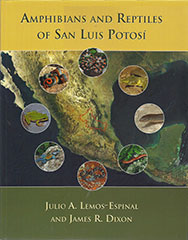
|
Amphibians and Reptiles of San Luis Potosí by Julio A. Lemos-Espinal and James R. Dixon Eagle Mountain Publishing, LC, Eagle Mountain, UT, 2013 A beautifully produced, authoritative reference on the herpetofauna of this Mexican state. In addition to one or more excellent color photographs, each species account includes sections on Identification, Morphology, Coloration, Distribution, Habitat, Behavior, Diet, Taxonomy, Etymology, and Protection Status. Unlike the Lemos-Espinal/Smith Mexican state reference books, all text is in English. Small dot-locality range maps are grouped together in the back. |

|
Amphibians and Reptiles of the State of Coahuila, Mexico by Julio A. Lemos-Espinal and Hobart M. Smith Universidad Nacional Autónoma de México, México, 2007 Large-format, authoritative guide to the herpetofauna of Coahuila. Most of the content is included twice, once in Spanish and once in English. Printed in a fairly low-budget way to keep the price down, but rich in content. About 90 pages of color photos gathered together, and 16 pages of dot-locality maps. |

|
Amphibians and Reptiles of the State of Chihuahua, Mexico by Julio A. Lemos-Espinal and Hobart M. Smith Universidad Nacional Autónoma de México, México, 2007 Same format as the Coahuila guide listed above. An indispensable reference for herping in this part of Mexico. |

|
Cane Toads: An Unnatural History by Stephanie Lewis Dolphin/Doubleday, New York, NY, 1989 This is a slim mass-market companion to the film of the same name (available on video). Book and film both describe the unfortunate history of Bufo marinus in Australia. This toad was introduced in hopes that it would save the sugar cane crop by eating the beetles that ate the sugar cane, but instead the toad has been spreading rapidly across Australia eating practically everything else. It's more a cultural than natural history book, but it does contain some interesting information about Bufo marinus, and it is funny. |
|
|
A Checklist of Amphibians and Reptiles of Chiricahua National Monument by Charles H. Lowe and Peter A. Holm Southwest Parks and Monuments Association, Tucson, AZ, 1992 This is a simple checklist of herps present or suspected in this Arizona National Monument. Includes common and scientific names, habitat types, and abundance information. Does not include subspecies, unfortunately. |

|
Komodo: The Living Dragon (Revised Edition) by Dick Lutz & J. Marie Lutz Dimi Press, Salem, OR, 1997 This light-weight book is aimed at the mass market, as is evident from the lurid cover photo of a lurching dragon coming straight at the camera with bright red (color-enhanced?) blood oozing from its jaws. It's got pretty good coverage of the history of human's relationships with V.komodoensis, including a very detailed account of which Komodo dragons have been in which zoos when. The information about dragons in the wild is patchy. It's got a few pages of color photos, and a few more black and white ones. If you're seriously interested in this species, track down the Auffenberg book. |

|
Reptiles & Amphibians of the Eastern Caribbean by Anita Malhotra and Roger S. Thorpe Macmillan Education Ltd, London, England, 1999 This is an attractive little introduction to the herps of the Eastern Caribbean, also known as the Lesser Antilles. It has a comprehensive description of the herpetofauna of one example island, Dominica, and a briefer description for each of the other significant islands in the area. It's not organized like a field guide and there are no range maps or field-guide-like species accounts, but it contains a lot of solid information on the herps of the area. It includes a checklist of species by island. Very nice photographs of herps in their natural environment are scattered throughout. |
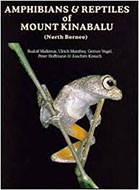
|
Amphibians & Reptiles of Mount Kinabalu (North Borneo) by Rudolf Malkmus, Ulrich Manthey, Gernot Vogel, Peter Hoffmann & Joachim Kosuch A.R.G. Gantner Verlag K.G., Königstein, Germany, 2002 A wonderfully complete and specific study of the herps of a small but species-rich part of Sabah, Borneo. It's kind of a cross between a very detailed field guide and a series of species-definition-style journal articles. Very good to excellent color photos for nearly every species. Dot-locality maps for some species, and often quite precise descriptions of the ranges of all species. It's translated from German, which is sometimes a little awkward, but never hard to follow. One really nice feature is a dichotomous key for every genus that is found in the Mount Kinabalu area, including even the species in that genus that are only found elsewhere in Borneo. The taxonomy is somewhat outdated now, and obviously a lot more has been learned in the years since this was published, but overall this is an excellent reference if you plan to visit Mount Kinabalu, and even if you will only be elsewhere in Borneo. I imagine not very many copies were printed, as it is hard to find for a less than outrageous price. Happily, the entire book is available as a free PDF online. |

|
Agamid Lizards of Southern Asia: Draconinae 1 by Ulrich Manthey Edition Chimaira, Frankfurt, Germany, 2008 This is part of a planned many-volume series cataloguing the numerous agamids of this part of the world. This volume covers only the genera in the subfamily Draconinae that start with letters A - D. (Man there are a lot of agamids!) It's essentially an exhaustive photo collection that also includes detailed color range maps. Most taxa are illustrated with multiple photos to illustrate subspecies and variation, in some cases many photos. For example, Calotes cf. versicolor versicolor is illustrated with 27 (!) photos. There are about 15 pages of text in both English and German and about 150 pages of photos, with two to six photos per page. If you ever have the need to identify a particular flying dragon (genus Draco), then you need this book. |
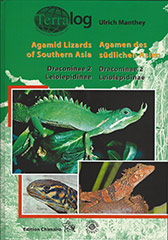
|
Agamid Lizards of Southern Asia: Draconinae 2 by Ulrich Manthey Edition Chimaira, Frankfurt, Germany, 2010 Part 2 picks up with Gonocephalus and polishes off the rest of the Draconinae. It also throws in Leiolepidinae for good measure, and the genus Physignathus. So many photos! |

|
Amphibien & Reptilien Südostasiens by Ulrich Manthey and Wolfgang Grossmann Natur und Tier - Verlag, Münster, Deutschland, 1997 This is a beautiful and authoritative full-color textbook-sized volume officially covering Thailand, Malaysia, Singapore, Indonesian Borneo (Kalimantan), Sumatra, and Java. Its range maps also cover Bali to Timor, Sulawesi, and the Moluccas, but species are only included if they're in the officially-covered region. This was unfortunate for me, since I was using it for the Bali-to-Komodo region. It's also unfortunate for me that the book is in German, of which I know very little. But it has excellent color photos of most species, and line drawings to illustrate some points. It also includes identification keys that turn into tables of characteristics at the species level. My only real gripe with this lovingly produced book is that range maps are given only for each genus; ranges for species are described, not very precisely, in words. |

|
Masters of Disguise: A Natural History of Chameleons by James Martin, photographs by Art Wolfe Facts on File, New York, N.Y., 1992 This is a lavishly illustrated semi-popular account of everyone's favorite swivel-eyed, prehensile-tailed, color-changing, pneumatic-tongued lizards. It's not a completist work; in fact, only four species are covered in depth, though the entire chameleon taxonomy is presented. It's very readable without being simplistic. Art Wolfe's photographs throughout are just stunningly good. |

|
A Field Guide to Reptiles and Amphibians in the Hawaiian Islands by Sean Mckeown Diamond Head Publishing, Inc., Los Osos, CA, 1996 Included in this very attractive field guide is the statistic that of the 33 species listed, the only ones actually native to Hawaii are the marine turtles and sea snakes. So it's really almost entirely a field guide to the introduced reptiles and amphibians in Hawaii (note the careful choice of preposition in the book title). That said, it's a very high quality field guide, containing several good large color photos of most included species. It's got a nice write-up for each species which includes captive care information (and legality issues for some species). I've used this book to help identify species living in Florida and in Indonesia, so it's definitely useful even if you have no Hawaii trip planned. |

|
Amphibians and Reptiles of Baja California by Ron H. McPeak Sea Challengers, Monterey, CA, 2000 This is a simple and attractive regional identification guide. Each species gets a short to medium paragraph of text and a very nice color photograph, or occasionally two photographs. There's a personal touch throughout in the sentences that describe the photographed specimens. Unfortunately there are no range maps; for those and for much more detailed information, you'll have to break out Grismer's massive Baja book. |

|
The Exotic Amphibians and Reptiles of Florida by Walter E. Meshaka, Jr., Brian P. Butterfield, and J. Brian Hauge Krieger Publishing Company, Malabar, FL, 2004 This is an interesting twist on the standard field guide, since it includes species accounts only of non-native species. There's a little information to identify each species, and a wealth of detail about how each species was introduced into Florida (in some cases, multiple times), where they are thought to live now, what they've been eating while in Florida, and how they've been known to reproduce while in Florida. Very helpful for pinpointing where we herp-seekers can best hope to find these numerous exotic species. |
|
|
Wet Forest Frogs of South-east Queensland by Ed Meyer, Harry Hines, & Jean-Marc Hero Griffith University, Queensland, Australia, 2001 This specialized pamphlet/book is cleverly packaged for carrying into the field. It's small enough to slip into a large pocket or any bag, seals shut with a velcro attachment to keep it from getting easily mangled, and is printed on slick waterproof paper. It includes illustrated dichotomous keys as well as detailed species accounts with two or three photos clearly illustrating distinctive features for each frog found in the area. |

|
A Guide to the Frogs and Toads of Belize by John R. Meyer and Carol Farneti Foster Krieger Publishing Company, Malabar, FL, 1996 This slim hardback features species accounts of all 33 anurans known to occur in Belize at the time it was published, each illustrated with one color photo. The photos range from decent to excellent. Good identification information for each species, but suffers from a lack of range maps. |

|
The Lives of Desert Animals in Joshua Tree National Monument by Alden H. Miller and Robert C. Stebbins University of California Press, Berkeley, CA, 1973 This handsome volume is the result of a multi-year survey of the vertebrates living on Joshua Tree National Monument (now National Park). 80+ pages are devoted to herps, illustrated with black and white photos (and one color photo of a Collared lizard). Stebbins of Western Field Guide fame wrote this herp section. Each species gets a multi-page writeup with very specific information about the habitat, distribution and natural history. This book is especially useful for visitors to the Joshua Tree area who are looking for specific herps, since it lists locations, times of year, and times of day at which different species can be seen. |

|
Arizona Wildlife Views, Special Edition by D. Charone Monday and Roberta Dobolek, editors Arizona Game and Fish Department, Phoenix, AZ, 1999 Arizona Wildlife Views is the periodical of the Arizona Game and Fish Department. I haven't seen any other issues, so I can't tell you what it's usually like. This special edition collects together and updates species accounts that had been published separately in earlier issues. The herps sections are informative and entertaining, with great photographs. Only a handful of the many Arizona species are included, though; this isn't a complete field guide to Arizona herps by any means (but I wish someone would write one!). |
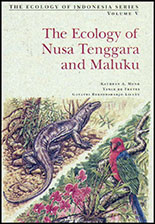
|
The Ecology of Nusa Tenggara and Maluku The Ecology of Indonesia Series, volume V by Kathryn A. Monk, Yance de Fretes, Gayatri Reksodiharjo-Lilley Periplus Editions, Singapore, 1997 This mammoth volume is one of a series that brings together information about nature in Indonesia from a variety of sources. It has a handful of color photos and lots and lots of text. Not much on herps, but it does include a valuable table listing which herp species inhabit which islands in the area. I took notes from a reference copy on the boat, and found a picture of the cover on the web. |

|
Chameleons: Nature's Hidden Jewels by Petr Necas Krieger Publishing Company, Malabar, FL, 1999 This is a serious and authoritative yet approachable work on this most interesting of lizard families. It's translated from the original German passably but with enough obvious errors to keep you on your toes. It starts with chapters on general natural history, systematics, cultural history, and captive care. Then the bulk of the book comprises species accounts for many (but not all) chameleon species. Each species account includes both natural history and captive care notes. Unfortunately, the species' ranges are described in words; there are no maps. Altogether an attractive, solid volume, and a must for any chameleon fan. |

|
Common Amphibians of Costa Rica by David Norman Privately published, Heredia, Costa Rica, 1998 Simple field guide, aimed at the layperson. 36 species are illustrated with good photos and sometimes line drawings. Each listed species has a page of text in both English and Spanish. The text always includes a description, and sometimes distribution, habitat, and/or behavioral information. Some of the species illustrated here are not illustrated in any other book I've personally seen, so I was grateful for this little volume. |
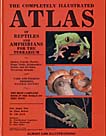
|
The Completely Illustrated Atlas of Reptiles and Amphibians for the Terrarium by Fritz Jürgen Obst, Dr. Klaus Richter, and Dr. Udo Jacob T.F.H. Publications, Inc., Neptune City, NJ, 1988 This is a behemoth of a book that would crush most coffee tables under its weight. It's aimed at the herp-keeper, as the title implies, but has a good amount of natural history information also. Perhaps its main claim to fame is the "completely illustrated" aspect; it's loaded with color photographs, hundreds and hundreds of them, most quite good. It's organized alphabetically like an encyclopedia. You'll find entries for families and genera, as well as various other topics of interest to the herpetologist or herpetoculturist, ranging from Acariasis (mite and tick infestations) to a definition of Zoogeography. I both browse it and check it for confirming photographs of species I think I might have seen. |

|
Salamanders of the United States and Canada by James W. Petranka Smithsonian Institution Press, Washington D.C., 1998 The modern standard in salamandrology (caudation?). All the ingredients of a great field guide -- excellent photos, accounts for every species, range maps -- combined with exhaustive and well-written biological and ecological information and a comprehensive bibliography. At least one excellent color photo for each species in a central section, and hundreds of black and white photos throughout. You wouldn't really want to use this as a field guide because it's too large, heavy, and expensive to take into the field, but you would definitely want to use it as a just-back-from-the-field guide. |

|
Varanoid Lizards of the World by Eric R. Pianka and Denns R. King with Ruth Allen King, editors Indiana University Press, Bloomington, IN, 2004 Authoritative overview of monitor lizards (family Varanidae) and their cousins (Gila Monster, Mexican Beaded Lizard, Borneo Earless Monitor, and the extinct but still quite impressive Estesia mongoliensis). After a few rich introductory essays about the evolution and biogeography of these lizards, each extant species and an extinct one or two are given full, detailed species accounts. The accounts are written by experts on each species, but the variety of authors doesn't detract from the book's continuity, because the editors have done a fine job in smoothing over stylistic differences. I was pleasantly surprised to discover that Steve "The Crocodile Hunter" Irwin contributed the species account for Varanus keithhornei, so he must be something of an academic when he's not putting on a show. Range maps and some black and white photos throughout; large, excellent color photos grouped in two sections. |

|
Madagascar: A Natural History by Ken Preston-Mafham Facts On File, New York, NY, 1991 Big coffee-table book covering geology, flora, and fauna of Madagascar. Not a comprehensive guide, but well written and beautifully illustrated. Probably too big to bring to Madagascar with you (that's what Bradt's Madagascar guide is for), but anyone interested in Malagasy wildlife will love this book. Includes a useful appendix listing national parks and nature reserves and which species can be found in them, which you probably would want to bring to Madagascar with you, or at least use to help plan your trip. I guess that's what copy machines are for. |

|
New Zealand Amphibians & Reptiles by Joan Robb William Collins Publishers Ltd, Auckland, New Zealand, 1986 This large format paperback runs rings around the tiny New Zealand field guides by Gill and Gill and Whitaker. It features multiple photographs (some color, some black and white) and detailed information about each species known to exist in New Zealand at the time of publication. I wish there were a newer version that took into account the increases in herpetological knowledge over the last 20 years, but you can't have everything. |

|
Guide to the Frogs of the Iquitos Region, Amazonian Peru by Lily O. Rodríguez and William E. Duellman The University of Kansas Natural History Museum, Lawrence, Kansas, 1994 An authoritative and well-organized guide to the many frogs in this area, perhaps the most frog-diverse area in the world. The photos are grouped together in the back, with a helpful key that specifies the size of the frog in life compared to the size in the photo. The species accounts aim to identify the species clearly, and there are also a few natural history notes where known. Further research on the frogs in this area has obsoleted many of the names used in this book, and many new species have been discovered or separated out, but I still found this book very useful when trying to identify frogs I saw in this area. |

|
Lizards by Manfred Rogner Krieger Publishing Company, Malabar, FL, 1997 This is a two-volume set that covers the natural history and captive care of lizards and, surprisingly, tuataras and crocodilians, on a genus-by-genus, species-by-species basis. The information is spotty -- you never know whether a species will be included or not, and some of the included species get much more coverage than others. Also, it's somewhat awkwardly translated from the original German, and some of its taxonomy is non-standard. Still, it's got lots of photographs of common and obscure lizard species, and sometimes it has just the information you're looking for. Volume 1 covers Geckos, Agamas, Chameleons, and Iguanas |
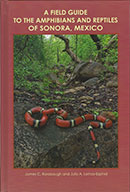
|
A Field Guide to the Amphibians and Reptiles of Sonora, Mexico by James C. Rorabaugh and Julio A. Lemos-Espinal ECO Herpetological Publishing and Distribution, Rodeo, New Mexico, 2016 A well-researched and beautifully produced field guide to the herps of this Mexican state. It is quite large to be carried into the field, but very handy if you do. Each species gets two or three pages of description and natural history notes, with one to several photos mixed in. Information to distinguish similar species is a particularly useful focus. Reasonably large and detailed range maps are provided with each species account. Subspecies are generally ignored, though occasionally one will be mentioned. |

|
The Garter Snakes: Evolution and Ecology by Douglas A. Rossman, Neil B. Ford, and Richard A. Siegel University of Oklahoma Press, Norman, OK, 1996 When it was published in 1996, this was the definitive account of the wide-ranging genus Thamnophis. It probably still has that title, but parts of it have grown stale. For instance, this book was published during the relatively brief interval when some authorities concluded that the San Francisco Garter Snake's historic scientific name was improperly applied, thus causing a ripple effect in garter snake scientific names that confused many before the ICZN restored the traditional order. Anyway, taxonomic quibbles aside, the book has complete but fairly dry and academic accounts of each Thamnophis species in the world, including the Mexican species that don't receive as much coverage as those in the U.S. Good range maps accompany the species accounts; smallish color photographs are grouped together. |

|
The Lizard-Watching Guide by Sherburn R. Sanborn Lorraine Press, Salt Lake City, UT, 1994 This delightful glossy booklet is about watching lizards in the wild. It highlights 17 species found in the Mojave and Colorado deserts in Southern California with excellent one- to two-page accounts, each with a very high-quality photograph. My favorite detail is the short list of very specific sites where you might expect to find each species. Also includes some well-done general material on lizard behavior and ecology. |

|
The Amphibians and Reptiles of Costa Rica by Jay M. Savage The University of Chicago Press, Chicago, 2002 As close to perfection as you're ever likely to see. A mammoth volume of beautifully written and beautifully illustrated herpetological goodness. Photographs, many by the magnificent Michael and Patricia Fogden, are gathered in four sections. Precise line drawings to illustrate distinctive features are scattered throughout. Every species known to occur in Costa Rica is described in significant detail, and nearly every species is illustrated with a photograph and a range map. Before the species accounts, Savage waxes eloquently about classification, biogeography, snakebite, how to find herps in the wild, and many other topics. Staggeringly good. |

|
Introduction to the Herpetofauna of Costa Rica by Jay M. Savage and Jaime Villa R. Society for the Study of Amphibians and Reptiles, Oxford, OH, 1986 Comprehensive but dry for the layperson. No photos; a few line drawings to label body parts. Dichotomous keys for each group. Distributional checklist and bibliographic index that cover all the species recorded in Costa Rica. The taxonomy is growing more obsolete daily as research continues; Savage is working on a huge updated comprehensive work on the herpetofauna of Costa Rica which when it appears will render this book instantly pointless. |

|
Treefrogs of Africa by Arne Schiøtz Edition Chimaira, Frankfurt am Main, Germany, 1999 A comprehensive review of the several African treefrog genera. Most species are illustrated with color photos (scattered throughout). Most species' ranges are mapped. Since many species are extremely variable in appearance and are distinguished primarily by call, sonograms accompany many species accounts also. Quite technical, but useful to the more casual frogger due to the good descriptions, many photos, and range maps. |

|
A Natural History of California by Allan A. Schoenherr University of California Press, Berkeley and Los Angeles, CA, 1992 A thick, rich volume that covers geology, plant communities, and animals of every region in California. Such a huge topic can't be exhaustively treated in one book, of course, but Schoenherr does a great job of choosing interesting details and illuminating examples. And he's written some shorter works on herpetology, so it's no surprise that the herps don't get short shrift. |

|
A Guide to the Identification of the Amphibians and Reptiles of the West Indies Exclusive of Hispaniola by Albert Schwartz and Robert W. Henderson Milwaukee Public Museum, Milwaukee, WI, 1985 This is the companion volume to the same authors' 1984 treatment of herps on Hispaniola. It's a similar format, but larger and with a lengthy color section of paintings of anoles, showing their heads, shoulders, and dewlaps (as on the cover). This color section includes some Hispaniolan anoles, so the anole-watching visitor to Hispaniola will really want both of these books. |

|
Amphibians and Reptiles of the West Indies: Descriptions, Distributions, and Natural History by Albert Schwartz and Robert W. Henderson University of Florida Press, Gainesville, FL, 1991 This large volume contains no pictures but lots of great information. It's got excellent range maps for each species that include exact sighting locales and the subspecies ranges, similar to the range maps in the Catalogue of American Amphibians and Reptiles. Each species also gets a detailed description and natural history notes. |

|
Amphibians and Reptiles of Bidwell Park by Jackson D. Shedd Quadco Printing, Chico, CA, 2005 The scope of Shedd's book is geographically narrow: a single municipal park in the city of Chico, located in Butte County, California. But don't ignore this gem just because you might not have heard of Bidwell Park, or you will be missing out. This is a first-class, taxonomically current field guide, with extensive information on each species known or believed to live in this large (3670 acres) park. Each species is illustrated in a set of beautiful color paintings by the author, similar in style to the classic work of Stebbins (but larger, due to the larger pages). In fact, the whole book reminds me strongly of reading Stebbins, but since the focus is so narrow the text can afford to be more richly detailed; if Stebbins's guide had this much info per species it would need to be divided into several volumes. |

|
Horned Lizards: Unique Reptiles of Western North America by Wade C. Sherbrooke Southwest Parks and Monuments Association, Globe, AZ, 1981 This hard-to-find little gem is a must for horned lizard fans. It's a beautifully designed 48-page booklet covering the 7 horned lizard species found in the U.S. Its range map and identification key are works of art and outstanding examples of information design and layout. It includes excellent and well-chosen color photos illustrating many of the adaptations that define these lizard's unusual lifestyles. The text is written for the layperson but not simplified; it taught me a lot about horned lizards, and I thought I already knew a lot about horned lizards. On the inside back cover, a table clearly illustrates which species can be found in which U.S. National Park "Service Units" (National Parks, National Monuments, National Historic Sites, etc.) Use it to plan your next vacation! |
|
|
Introduction to the Horned Lizards of North America by Wade C. Sherbrooke University of California Press, Berkeley, CA, 2003 This is an expanded and contracted version of Sherbrooke's earlier wonderful book on horned lizards. It's expanded because it now includes the Phrynosoma species that live in Mexico as well as those from the U.S. and Canada, and because the text has been expanded and updated throughout. It's contracted because it is now the size and shape of a standard paperback book (though it is hardcover), very different than the giant-booklet format of the earlier volume. It also no longer contains the table of which species live in which National Parks and such, perhaps because the table becomes outdated, or perhaps due to conservation concerns, or perhaps for some other reason. It remains excellent throughout, and you should really stop reading this and go buy a copy now. |

|
Snakes and Us: An introduction to East African Herpetology by H. A. Skinner Kenya Literature Bureau, Nairobi, Kenya, 1973 This little paperback is possibly useful to East African residents who know nothing about snakes and would like to know slightly more. Despite the "Herpetology" in the title, it's all about snakes. It has a little information on general natural history, collecting specimens, keeping captives, and what to do if you're bitten. A longish taxonomical "field guide" section finishes it off, though it lacks range maps or illustrations for most species. There are some color and some black & white photos in a center section, but they're probably the worst photographs I've ever seen in a reptile book, in every way that it's possible for photographs to be bad (out of focus, murky, wildly wrong colors, etc.). Fortunately, this book is hard to find. |

|
Handbook of Lizards: Lizards of the United States and Canada by Hobart M. Smith Comstock Publishing Associates, Ithaca, NY, 1995 This is a recent reprint of the 1946 classic on North American lizards. It's a big thick treatment of every lizard known or believed to occur in North America at the time it was written. Illustrated with black and white photographs scattered throughout, most designed to show salient features of the specimens, not all of which were alive. (I.e., the opposite end of the photographic spectrum from something like the Lizard-Watching Guide.) Includes large maps (collected together) and identification, appearance, behavior, and other natural history information for each species. The new forward puts it in historical context and updates the terminology and classification for the modern reader. |
|
|
Reptiles of North America: A Guide to Field Identification by Hobart M. Smith and Edmund D. Brodie, Jr. Golden Press, New York, NY, 1982 Solid but not outstanding little field guide for reptiles (but not amphibians, unlike most such guides). Illustrations are very good color line drawings, though not quite up to the quality of Stebbins. Text, illustrations, and range maps for several species are visible at the same time. This format works well for the text and illustrations, but the range maps suffer from extreme smallness. Also, the legend for the subspecies color-coding scheme used in the range maps is hidden near the front of the book, and must be consulted frequently unless you memorize the arbitrary sequence of colors. I'd recommend this one only if you've already got the Conant, Stebbins, and Behler & King guides, and still want more along the same lines. I did, and I don't regret it. |
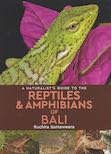
|
A Naturalist's Guide to the Reptiles & Amphibians of Bali by Ruchira Somaweera John Beaufoy Publishing Ltd, Oxford, England, 2017 A compact, beautiful, modern field guide to the herps of this one well-known Indonesian island. It covers all 111 known species from the island, with some speculation about others that might be present or might have been historically present. Species accounts are a full page, occasionally two, accompanied by one to three variably sized photos. No range maps. |
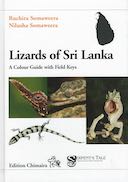
|
Lizards of Sri Lanka: A Colour Guide with Field Keys by Ruchira Somaweera & Nilusha Somaweera Edition Chimaira, Frankfurt, Germany, 2009 An authoritative, comprehensive guide to all Sri Lankan lizards known at the time of publication. Each species account includes one to 10+ usually excellent photos of each species, along with detailed comments about range, distribution in SL, diagnosis, length, natural history, taxonomic notes, and conservation status. Illustrated dichotomous keys for each family. Also includes significant introductory material, a glossary, and extensive references. Really well done, though starting to get a little outdated. |
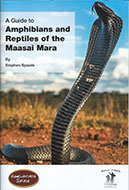
|
A Guide to Amphibians and Reptiles of the Maasai Mara by Stephen Spawls Gamewatchers Safaris Ltd, Nairobi, Kenya, 2017 A small (40-page), attractively produced pamphlet on the herps known and suspected to exist in this particular Kenyan conservation area. Each known-to-exist species account is a single color photo and a paragraph of description and natural history, along with the scientific name, an English common name, and sometimes one or two African common names. Indispensable if you will be visiting or have visited this part of Africa and want to identify any herps you encounter. |
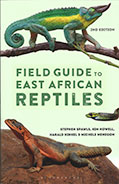
|
A Field Guide to East African Reptiles, 2nd edition by Stephen Spawls, Kim Howell, Harald Hinkel & Michele Menegon Bloomsbury Wildlife, London, 2018 A beautiful, hefty, comprehensive field guide. How I wish I already had this in my hands when I visited Uganda and Kenya in 2000. Scientific enough for serious herpetologists, but written in an accessible way for non-experts. Range maps for all species, and very good color photographs for most. Some very well-written introductory material in addition to the comprehensive species accounts. The first edition of this book came out in 2002 with a slightly different title and an overlapping set of authors. It was welcomed at the time, but herpetology moves fast these days, so you should seek out the 2nd edition. (Probably much easier to find than the older book anyway.) |

|
Reptiles of the Northwest by Alan St. John Lone Pine Publishing, Renton, WA, 2002 An extremely nice regional field guide for the North American Pacific Northwest, including sourthern Alaska, most of British Columbia, all of Washington, Idaho, and Oregon, and parts of California, Nevada, Utah, Colorado, Montana, and Wyoming. There is more information per species than in most field guides, and St. John includes many personal touches. For example, each species has a section of interesting and entertaining field notes that make me want to drop what I'm doing and get out in the field. Color throughout, with many photographs of each species, and clear and attractive range maps printed with each species account. |

|
A Guide to the Reptiles of Belize by Peter J. Stafford and John R. Meyer The Natural History Museum, London, 2000 A stylish, modern field guide, akin in spirit to Bartlett's excellent Florida guide. Very good color photographs accompany the species accounts throughout. The text is well-written, interesting, and full of just the right details. Clearly this is the new standard for reptiles in Belize. My only gripe is the absence of maps; ranges are described in words, usually just to the district level. |

|
California Reptiles and Amphibians by Robert C. Stebbins University of California Press, Berkeley, CA, 1972 Until 2012, this was the most recent guide to all California herps. In 2012 a "revised edition" was released, coauthored by Samuel M. McGinnis. This new edition was published right at the end of Stebbins's long life, and it is questionable how much Stebbins himself contributed to it. Most people in the herpetological community found it very disappointing, and I am not including it here. This original version contains essentially a subset of the information and illustrations in Stebbins's definitive Peterson Field Guide, and thus is mostly interesting only for historical reasons. However, it does have a few touches missing from the later book, including a series of charming drawings that illustrate various behaviors, such as a newt laying eggs and a Southern Alligator Lizard using its tail while climbing. |

|
Peterson Field Guide to Western Reptiles and Amphibians, Third Edition by Robert C. Stebbins Houghton Mifflin Company, New York, NY, 2003 The standard field guide for the western United States. Photo-quality color drawings of every species. Excellent accounts and range maps for every subspecies. Some people dislike the grouping of all illustrations together and all maps together, but I grew up with it this way and can't imagine otherwise. If you're interested in U.S. herps, you need this and its eastern/central companion. Make sure you get the third edition, since our knowledge of North American herps has grown considerably in the 18 years between the 2nd and 3rd editions. A 4th edition was released in 2018, five years past Stebbins's death. Coauthor Samuel McGinnis was added, and presumably was solely responsible for the changes in content. The herpetological community has strongly rejected this 4th edition, and I am ignoring it here. |

|
Snakes and other Reptiles of the Southwest, 4th Edition by Erik D. Stoops and Annette Wright Golden West Publishers, Phoenix, AZ, 1997 With its bright yellow cover and the word "SNAKES" in a huge typeface looming over a rattlesnake, this book appears marketed towards tourists and the impressionable. It's not that bad, but it's not great either. The species accounts are brief and simple. The 63 full-color photos! that the cover promises range from excellent to poor. They are grouped together, with black and white photos illustrating the species accounts throughout. Though this book doesn't arbitrarily limit the species, 50 Common Reptiles & Amphibians of the Southwest is a much better book. |

|
Reptiles of Washington and Oregon by Robert M. Storm and William P. Leonard, editors Seattle Audubon Society, Seattle, WA, 1995 Very good modern regional field guide. Range maps throughout, showing county lines (but not precise recording localities). Each species gets 2-4 pages, generally with 2-5 large color photographs accompanying the species account. There's a list of 6 authors in addition to the 2 editors, so I suspect the information is especially accurate. |

|
Lizards of Western Australia, Part I, Skinks, Revised Edition by G.M. Storr, L.A. Smith and R.E. Johnstone Western Australian Museum, Perth, 1999 When I first saw this book, I almost laughed out loud at the title. It amazes me that it requires three volumes to cover not all herps, not all reptiles, but just the lizards of not all of Australia, but just one of its states. The book is a very thorough but fairly dry field guide, with nice large range maps for each species and scale pattern illustrations for many species along with detailed identification information. Basically nothing on behavior though. The photos are grouped together, four and six to the page. The book includes detailed dichotomous keys for the different groupings, and a very nice glossary. |
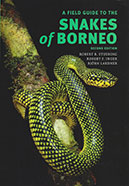
|
A Field Guide to the Snakes of Borneo, Second Edition by Robert B. Stuebing, Robert F. Inger, and Björn Lardner Natural History Publications (Borneo), Sabah, Malaysia, 2014 A very nice modern-style field guide, well organized and well written. This second edition includes accounts for every snake species known from Borneo (as of publication date, of course). The species accounts are a page or two long, with detailed descriptions and some interesting natural history info. Most species have one or two very good photos, often in natural or at least naturalistic settings. Text descriptions of range, but no maps. |
|
|
A Photographic Guide to Snakes & Other Reptiles of Australia by Gerry Swan Ralph Curtis Publishing, Inc., Sanibel Island, FL, 1995 Another in the series that includes my trusty English-language Southeast Asia guide. Quite a nice little book for its size, with very good photographs and small but effective range maps. You can carry this one around with you, and keep one of the larger more comprehensive Australian reptile guides like Cogger or Wilson & Knowles or Wilson & Swan back at the billabong with your didgeridu for reference. |

|
Field Guide to Australian Reptiles by Stephen Swanson Steve Parrish Publishing, Archerfield, Queensland, Australia, 2007 A decent overview of Australian reptiles, Good to very good photos, fairly large and mostly in natural habitats, and a decent amount of description of each listed species. But it does not attempt to be complete; it includes only about 350 of Australia's more than 900 species. Because of this, it's nowhere near as useful of a field guide as Wilson and Swan. |

|
Birds, Mammals, and Reptiles of the Galápagos Islands: An Identification Guide, 2nd Edition by Andy Swash and Rob Still Yale University Press, New Haven, CT, 2005 An attractive and compact photographic guide. Right-hand pages are filled with a variety of photographs, sometimes tiled, sometimes extracted and placed on a single background. Left-hand pages contain species descriptions and maps. Includes all native and introduced reptiles (a few geckos are introduced). |

|
A Field Guide to Snakes of Florida by Alan Tennant Gulf Publishing Company, Houston, TX, 1997 An excellent, modern field guide to Florida's slithery denizens. Good introductory material on habitats, including a table mapping every Florida snake species to every Florida habitat. Excellent color photos grouped together. Range maps with species accounts. This is the companion volume (same publisher, very similar design) to the Bartletts' Florida herp guide. |

|
Snakes of Florida, Second Edition by Alan Tennant Taylor Trade Publishing, Lanham, Md, 2003 This is exactly the same book as the earlier edition, but for a new publisher, a new cover, and an article on the evolution of snakes inserted just before the glossary. Calling it a "second edition" seems to be stretching things a bit. I suspect its reappearance with a new publisher had something to do with the publication of Bartletts' new guide to Florida's snakes, which came out the same year. |
|
|
Reptiles & Amphibians of the Smokies by Stephen G. Tilley and James E. Huheey Great Smoky Mountains Natural History Association, Gatlinburg, TN, 2001 You might pass by this book due to its small size and specific coverage area, but if you did so, you would have missed out on an inexpensive gem of a field guide. Both authors are professional biologists with expertise on salamanders, and there are no fewer than 30 salamanders represented in this book, but other herps receive equal treatment. Each of 80 species is represented by one or occasionally two pages, with one or occasionally two excellent color photographs, a sentence or two each for Description, Habitat, and Similar Species, and a half-page or so of interesting natural history info, often including specifics on where to find this species in this national park. The text is informal, suitable for enthusiasts but simple enough for anyone. Significant general herp info and specific Smoky Mountains info is provided before the species accounts. It would be foolish to visit the Great Smoky Mountains without this book, unless you have no interest in herps (in which case you should really not be reading this webpage). |

|
Catalogue of American Amphibians and Reptiles by various editors and even more authors Society for the Study of Amphibians and Reptiles, Saint Louis, MO, 1962 This is the definitive set of species accounts for amphibians and reptiles of the western hemisphere. Each account was written by a specialist on that species, and includes identification details, an illustration or two (older ones are black and white, most of the newer ones are color), a detailed locality map, a comprehensive bibliography, and other information. Aimed at the herpetological researcher, but also useful for knowledgeable amateurs. I believe the series is no longer being updated, but all the accounts are now available online. |
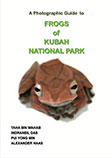
|
A Photographic Guide to Frogs of Kubah National Park by Taha Bin Wahab, Indraneil Das, Pui Yong Min, Alexander Haas Sarawak Forestry Corporation, Kuching, Sarawak, Malaysia, 2014 If you're visiting Kubah National Park, you'll want a copy of this handy little guide to the frogs known from this frog-rich park in Sarawak, Malaysia. I found it online somewhere in PDF form; I've never seen it printed or advertised. 59 of the 68 species known from Kubah in 2014 are included. Each species account consists of one large photo, the scientific name, an English name, a local (Malay) name, maximum size, conservation status, and where in the park it has been seen. There's also an overview map of the park's trails. |

|
Reptiles and Amphibians of Zion National Park by Roland H. Wauer Zion Natural History Association, UT, 1964 Undoubtedly dated by now, this booklet consists mostly of species accounts of the 26 reptiles and 7 amphibians known to occur in Zion National Park when it was written. Each species account consists of a decent color photo and a half-page or so of text. The best part about this booklet is that it tells you specifically where and when to look for each species in Zion. An introductory section describes various habitats found in Zion and which herps live in each. |

|
Wildlife Watcher's Guide: Grand Canyon, Zion & Bryce by Todd Wilkinson Northword Press, Inc., Minocqua, WI, 1995 Not as herpetologically complete as Wauer's book, but replete with gorgeous photos and good information about where to look for each of the species they do call out. |

|
A Field Guide to the Reptiles of Queensland by Steve Wilson New Holland Publishers, Sydney, Australia, 2005 One might think that if you had Wilson and Swan's recent guide to all Australian reptiles, you'd be wasting your money also purchasing Wilson's slightly-newer guide to the reptiles of Australia's northeastern state. Fortunately, this is not the case, if only because Wilson seems to have taken great care not to duplicate the photographs from the earlier book in this one (perhaps for contractual reasons, who knows?). In some cases I recognize the same individual animal in the photographs in the two books, but never the same photo. The text per species is slightly longer here, but still fairly sparse (as is required to cover 440 species in a reasonably-sized book). The photographs in this book are mixed in with the text, rather than being on facing pages as in the earlier book; there are advantages to each approach, but I prefer this book's design. |

|
Reptiles of Australia by Steve Wilson and Gerry Swan Princeton University Press, Princeton, NJ, 2003 A stout and handy field guide. You might expect this to be similar to Wilson's earlier collaboration with David G. Knowles, but it's quite different. For one thing, very few if any of the photographs are repeated (though a number are similar). Also, the photographs in this one are throughout the book, facing the descriptions; there is somewhat less information per species in this one; and this one covers non-terrestrial reptiles too. Altogether an excellent modern field guide to the incredible diversity of Australian reptiles. In Australia, this guide has been updated periodically, with the latest update being the fifth edition. Since these newer editions are not available in the USA, I'm leaving this first edition in my list. |
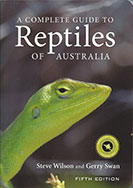
|
A Complete Guide to Reptiles of Australia, Fifth Edition by Steve Wilson and Gerry Swan New Holland Publishers, Sydney, Australia, 2017 This fifth edition has many taxonomic changes and newly described species compared to the first edition published a decade earlier. As far as I know, only the first edition was printed in the USA, so you'll have to track down an Australian printing if you want to see the taxonomic changes and new species from the last ten years or so. And you do, of course. |

|
Australia's Reptiles: A Photographic Reference to the Terrestrial Reptiles of Australia by Stephen K. Wilson and David G. Knowles Collins Publishers, Sydney, Australia, 1988 A large, comprehensive book. Its highlight is the photo section containing 847 decent-sized photos (6 per large page) of virtually every Australian lizard and terrestrial snake known at the time (sea snakes, turtles, and crocodilians are not included). Range maps accompany the photos, though all other information is kept separately in the text. The species information includes common names where well-established, description, preferred habitat, microhabitat, and comments. The habitat descriptions are especially helpful for those readers interested in seeking out these reptiles on their own, like me. My biggest gripe with this book, which is a small gripe, is that I would have liked to see the common names and especially page numbers for the species accounts listed in the section of photographs. Many of the species listed here have since been reclassified, so it's useful to compare with Cogger. |